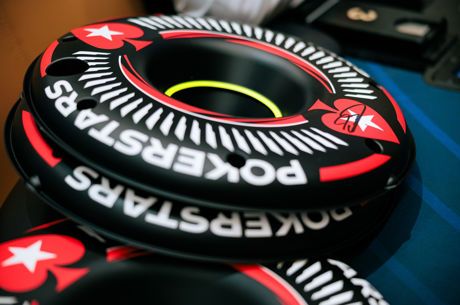Poker & Pop Culture: Digging for Gold (and Aces) in California

Saloons, steamboats, and soldiers.
When it comes to cultural representations of poker as it was played in the 1800s, the majority of portrayals of the game present it either as (1) a favorite recreation in drinking establishments; (2) a way to pass the time (or line the pockets) for travelers aboard early river paddle steamers; or (3) a preferred activity among those serving in the military, including the many who represented both the Union and the Confederacy during the Civil War.
Such is the case for both contemporary accounts of 19th-century poker and for the many attempts to recreate such scenes later, including decades' worth of cinematic "horse operas" that routinely placed an ongoing poker game in every saloon ever imagined. Those westerns invariably highlighted the risks and opportunities often associated with the Old (and often Wild) West, with a game of poker frequently providing a ready analogy with which storytellers could underscore intended themes and messages.
Continuing our survey of early poker, we'll next visit the saloons, where we'll necessarily encounter a number of the era's best known gamblers, among them Doc Holliday, Wyatt Earp, and Bat Masterson. We'll meet the exceptional Alice Ivers, a.k.a. "Poker Alice," who dealt and played in games in various saloons, then eventually owned her own establishment where poker was among the entertainments offered. We'll also sort through varying versions of that fateful, final hand played by Wild Bill Hickok at Nuttal & Mann's Saloon No. 10 in Deadwood in the Dakota Territory — easily the most famous hand of poker ever played in a saloon, and perhaps in all of poker's history.
But first let's head out west to California to visit another watering hole and talk about another hand of poker — and, as it happens, another Deadwood.
In Search of a Sure Thing
The frontier had at last reached the Pacific coast by mid-century, with California achieving statehood in 1850 just a couple of years after the "Gold Rush" had attracted hundreds of thousands to the northern and central parts of the soon-to-be-state.
James Hutchings, originally from England, had come to America months before news of California's gold spread across the continent, and soon found himself among the many "Forty-Niners" seeking fortunes. Hutchings enjoyed moderate success as a miner, but would ultimately make a better life for himself after investing in a printing press and becoming a publisher.

In 1856 Hutchings launched the very popular Hutchings' California Illustrated Magazine which for the next five years shared stories and sketches detailing life in California, with descriptions of the miners' experiences a frequently visited topic.
The magazine is credited with having popularized the Yosemite Valley, as Hutchings was part of one of the first groups to tour the area. It also shared early accounts of the Pony Express, the short-lived mail service that helped facilitate communications between the east and west and which carried copies of the magazine and its California stories all over the nation. Made up of longer features, shorter anecdotes, poems, and more, the magazine remains an important resource for scholars of the Old West.
Given the purpose of Hutchings' California Illustrated Magazine to share various facets of the new state's story with the world, isn't too great of a surprise to find amid tales of gold-digging, hunting, sightseeing, and descriptions of California's rich flora and fauna an account of a saloon poker game tucked into an issue from August 1858.
The gold rush had inspired a gambling boom throughout California, with the state and individual cities issuing licenses to various establishments — including saloons — to permit gambling. Gambling was especially popular in mining camps and towns, perhaps a natural pastime for risk-taking entrepreneurs with available funds.
A backlash against gambling immediately ensued, however, with various laws swiftly drawn up to curb its spread, and occasional stories of gamblers being lynched. As early as 1852, The San Francisco Herald noted that while gambling dens were "a prominent feature of life" in the city, "they are tolerated for no other reason, that we know of, than that they are charged heavily for licenses."
"There is such a place as 'Deadwood' in California," begins the unnamed author of the Hutchings' poker story, referring to one of a few possible Deadwoods that had already popped up in the northern part of the state by then (many years before the more famous one would emerge in the Dakota Territory). It was a popular name for newly-incorporated mining towns, directly derived from gold miners' jargon for a "sure thing."
The story appears probable enough to suggest it is rooted in fact. But there's perhaps enough embellishment as well to keep us from believing it to be wholly a sure thing.
Little Pairs, Big Bets
The report is filed by "Our Social Chair" (a regular feature), to whom the story was sent by a friend. While passing through Deadwood the correspondent had stopped in to witness a trial involving two well known residents of the town, Lem Hanks and Bill Breese. Both were found to have "violated the law by playing 'poker' on the Sabbath" (a local prohibition). Both also had been arrested at the scene when "the game broke up in a row" — i.e., a fight involving the pair.
But the only real point of contention — and what was in fact the focus of the trial — was Hanks accusing Breese of having "played very 'low down,' or, in other words, cheated" in their game.
Interestingly, neither of the players take the stand, but instead a witness named Stephen Lick is called to describe what is ostensibly a hand of five-card draw, with action picked up after the draw. Noting that "licker was pendin' on the outcome," Lick tells how betting between the two players began, adding as well how he was in close enough proximity to the table to see (somewhat improbably) that Hanks had a "little par" (of sixes, we learn) and that Breese "helt a little par, too" (of deuces).
The raises continue, starting with two bits and gradually growing as high as a hundred dollars before a final bet is called. Lick is quite descriptive, stopping occasionally to note how "Bill... got down then to scratch his foot" and "Lem... pushed his shirt sleeves up to keep it from gettin' dirty, I spose."
One of the lawyers objects. "We do not care about so much detail," he says, adding how only the amount ultimately wagered is of relevance.
Attentive readers, however, have probably already seized on the hints being dropped in Lick's narration.
The Devil is in the Details
The betting ends with Breese winking at Lick before taking down the pot. But the attorney representing Hanks has a reasonable question.
"How comes it that the defendant got that money, if he only had a pair of deuces against my client's sixes?" he asks.
Lick affirms that while indeed Breese initially had that "little par," "somehow when it came to the last, he was stronger."
At showdown, we learn, Hanks announced he had "three of 'em," each "with nice little spots, all in the middle of the keerd" — i.e., three aces. "That's clever," responded Breese coolly, "'cause here's four of the same sort," and surmising that four aces beat three claimed the pot.
Neither Breese's foot-scratching or Hanks pushing up his sleeves were innocuous, it turns out — with both acts the players were digging for extra aces. The author points out how Hanks and his attorney were in a difficult position. Sure, they could accuse Breese of cheating, but "would probably have been called on to explain how Lem got his three 'spots.'"
"The Judge saw through the case at once. He charged the jury that if they thought there was anything wrong in a man scratching his foot during a game of poker, they could so find; but if they thought such a movement was on the square, they would also be likely to pass over the act of fumbling with shirt sleeves, committed by the plaintiff."
After just three minutes of deliberation, the jury returned their verdict, giving the story a final pun for a punch line.
"It was a 'draw game,'" they ruled, and the judge dismissed the case.
From Sea to Shining Sea
Poker truly had grown into a national game, having expanded from coast to coast along with the country itself. Not only that, but stories of the game were being sent back and forth across the country as well, helping establish it even further as a point in common among players and readers located thousands of miles apart.
Despite the courtroom setting, the Deadwood, California game as described in Hutchings' California Illustrated Magazine more or less steers clear of ongoing, heated debates about gambling and/or poker, presenting the game in a light-hearted way while perhaps gently cautioning readers about the preponderance of cheating one was likely to encounter when playing.
The story would be later reprinted in 1928 as a pamphlet called "Poker As It Was Played in Deadwood in the Fifties," a doubly-misleading title. For one, by then the Deadwood reference would make readers think of South Dakota, not California. Neither can it be assumed with complete certainty the story describes poker "as it was played" during the 1850s in California saloons and gambling dens.
It gets us close, though, resembling as it does other poker stories of the era marked by drinking, deceit, and different kinds of draws — of cards, fists, and weapons.
From the forthcoming "Poker & Pop Culture: Telling the Story of America’s Favorite Card Game." Martin Harris teaches a course in "Poker in American Film and Culture" in the American Studies program at UNC-Charlotte.
Image (Hutchings’ California Illustrated Magazine):
Want to stay atop all the latest in the poker world? If so, make sure to get PokerNews updates on your social media outlets. on Twitter and find us on both and !









